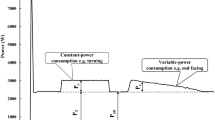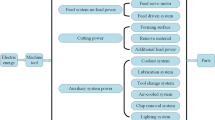Abstract
Accurate energy consumption prediction before actual turning is helpful for operators to select optimal processing parameters to improve energy efficiency. Tool wear is very fast in hard-to-process materials turning, which leads to the increase of cutting force, cutting temperature, and cutting power of machine tool. However, most existing prediction models do not consider the impact of tool wear on machine tool energy consumption. A new prediction model of machine tool energy consumption based on tool wear, spindle speed, and material removal rate in hard-to-process materials turning is developed, and verified with 06Cr19Ni10 stainless steel turning experiments. The experimental results show that the proposed model has higher prediction accuracy, and the maximum relative error between predicted value and true value is 2.9%. Furthermore, the influence of processing parameters and tool wear on machine tool energy consumption is studied. The machine tool energy consumption is proportional to the material removal volume, and linearly related to tool wear and spindle speed. The machine tool energy consumption decreases with the increase of material removal rate. The research results are helpful to formulate energy-saving turning scheme in hard-to-process materials turning.










Similar content being viewed by others
References
David AGZ, Mamun AA, Germanico GB (2018) An energy consumption approach in a manufacturing process using design of experiments. Int J Comput Integr Manuf 31(11):1067–1077
Department of Trade and Industry of United Kingdom (2007) Meeting the energy challenge. Government White Paper on Energy, http:// www.berr.gov.uk/files/file39564.pdf
Zhou LR, Li JF, Li FY, Meng Q, Li J, Xu XS (2016) Energy consumption model and energy efficiency of machine tools: a comprehensive literature review. J Clean Prod 112(5):3721–3734
He Y, Li YF, Wu T, Sutherland JW (2015) An energy-responsive optimization method for machine tool selection and operation sequence in flexible machining job shops. J Clean Prod 87(1):245–254
Gutowski T, Dahmus J, Thiriez A (2006) Electrical energy requirements for manufacturing processes. Proc Ann 13th CIRP Int Conf life cycle Eng: 623-627
Ma F, Zhang H, Cao HJ, Hon KKB (2017) An energy consumption optimization strategy for CNC milling. Int J Adv Manuf Technol 90(5–8):1715–1726
Duflou JR, Sutherland JW, Dornfeld D, Herrmann C, Jeswiet J, Kara S, Hauschild M, Kellens K (2012) Towards energy and resource efficient manufacturing: a processes and systems approach. CIRP Ann Manuf Technol 61(2):587–609
Lv JX, Tang RZ, Tang WCJ, Liu Y, Zhang YF, Jia S (2017) An investigation into reducing the spindle acceleration energy consumption of machine tools. J Clean Prod 143:794–803
He Y, Liu B, Zhang XD, Gao H, Liu XH (2012) A modeling method of task-oriented energy consumption for machining manufacturing system. J Clean Prod 23(1):167–174
Mori M, Fujishima M, Inamasu Y, Oda Y (2011) A study on energy efficiency improvement for machine tools. CIRP Ann Manuf Technol 60(1):145–148
Zhou Y, Zhang H, Yan W, Ma F, Li GF, Chang WJ (2018) Energy consumption component analysis mathematical model of grinder energy unit. Int J Comput Sci Math 9(6):612–620
Shen NY, Cao YL, Li J, Zhu K, Zhao C (2018) A practical energy consumption prediction method for CNC machine tools: cases of its implementation. Int J Adv Manuf Technol 99(9–12):2915–2927
Lee JY, Shin YJ, Kim MS, Kim ES, Yoon HS, Kim SY, Yoon YC, Ahn SH (2016) A simplified machine-tool power-consumption measurement procedure and methodology for estimating total energy consumption. J Manuf Sci Eng Trans ASME 138(5):1–9
Yoon HS, Singh E, Min S (2018) Empirical power consumption model for rotational axes in machine tools. J Clean Prod 196:370–381
Kara S, Li W (2011) Unit process energy consumption models for material removal processes. CIRP Ann Manuf Technol 60(1):37–40
Li L, Yan JH, Xing ZW (2013) Energy requirements evaluation of milling machines based on thermal equilibrium and empirical modeling. J Clean Prod 52:113–121
Jiang ZP, Gao D, Lu Y, Kong LH, Shang ZD (2019) Electrical energy consumption of CNC machine tools based on empirical modeling. Int J Adv Manuf Technol 100(9–12):2255–2267
Funding
This work was supported by the Project of Shandong Province Natural Science Foundation of China (No. ZR2016EEM29) and the Project of Shandong Province key research development of China (No. 2017GGX30114).
Author information
Authors and Affiliations
Corresponding author
Additional information
Publisher’s note
Springer Nature remains neutral with regard to jurisdictional claims in published maps and institutional affiliations.
Rights and permissions
About this article
Cite this article
Zhao, G., Zhao, Y., Meng, F. et al. Prediction model of machine tool energy consumption in hard-to-process materials turning. Int J Adv Manuf Technol 106, 4499–4508 (2020). https://doi.org/10.1007/s00170-020-04939-1
Received:
Accepted:
Published:
Issue Date:
DOI: https://doi.org/10.1007/s00170-020-04939-1




